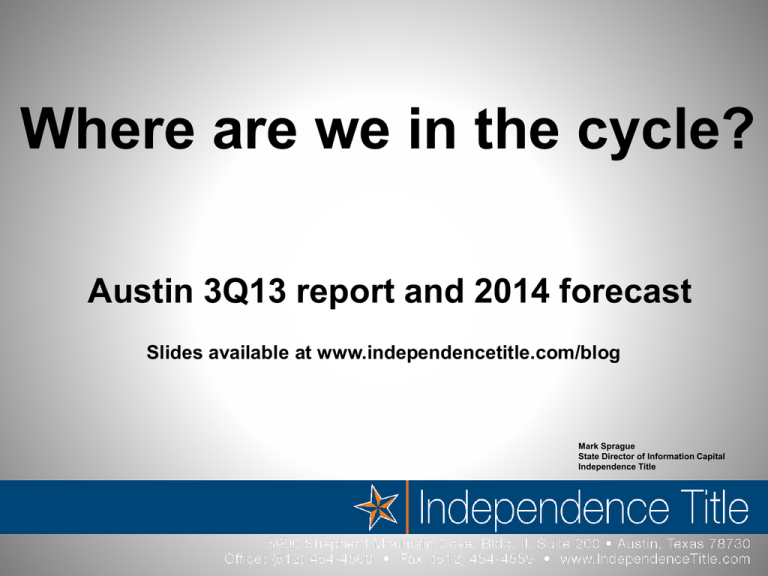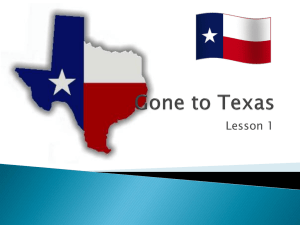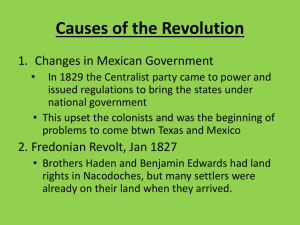Where are we in the cycle?
advertisement

Where are we in the cycle? Austin 3Q13 report and 2014 forecast Slides available at www.independencetitle.com/blog Mark Sprague State Director of Information Capital Independence Title Where are we in the cycle? Where are we, and where are we going? • National rebound started in 2011, slow progress 2012, 1st ten months 2013 strong local and regional recovery. – – • Employment – Nationally very slow recovering – – – – • • • • • • • • Austin and other major Texas metros rebound started in 2Q2010. Slow improvement nationally from worst economy in 60+ years Unemployment – US 7.3% (U6 13.77) / Texas 6.4% / Austin 5.3% Austin has 4th lowest unemployment of top 50 large US metros (over a million) Austin and Texas have been lower than the national avg. the last 80 months (6.5+ years) 11.3 million Americans remain unemployed. In Texas there are 816,845 without jobs, in Central Texas with an estimated 52,557 workers looking for work Real estate, auto, and retail sales have improved dramatically in Texas; slower nationwide Consumers are spending Real estate construction stronger across all channels nationally, Texas leading GDP growth improving slowly Interest rates have stayed low through most of 2013 5+ years of household & office formation pent up demand Corporate earnings continue to improve Housing and real estate slowly stabilizing, putting more people to work Projections for the next couple of years indicate substantive national growth won’t occur until late 2014 / 15 Where is Texas in the cycle? • • • • • • US – Stabilization – The Federal Reserve lowers rates, then gradually allows increase, as housing and job growth historically follow. When the rates are at zero, the Federal reserve uses other means, such as quantitative easing (QE) to encourage growth. Mildly effective. As Fed reduce stimulus, rates should rise. Texas – Recovery/Expansion – Supply and demand is in balance, and home, land, and office value appreciation meets or beats inflation. Austin – Expansion – Economic housing and job formation as well as other real estate channel demand exceeds supply. Housing and real estate appreciation stronger Houston – Expansion Economic housing formation as well as other real estate channel demand exceeds supply. Housing and real estate appreciation stronger San Antonio – Recovery Demand has picked up, putting pressure on supply Dallas / Fort Worth – Recovery Demand has picked up, putting pressure on supply All of this is caused by dynamic job growth in Texas. Where are Texas metros in the business cycle? Austin's economy outpacing other Texas metros Texas metro business cycle history Austin's economy outpacing other Texas metros Challenges from slow recovery • • • • National unemployment has improved, but still not recovered to prerecession; Texas has stabilized and is above pre-recession numbers. Wages flat. Lending and mortgage rates creeping up Real estate prices nationally are slowly improving. National and locally housing and commercial construction is just beginning to recover. It has not lead the recovery as it has in past recessions Mortgage and CRE lending standards still challenged for another 2-4 years – – • • • • Commercial real estate regionally has improved, not as big a drain on community and regional banks. Regionally commercial lending strong as evidenced by construction. Banks want to lend more, but new regulations are making it difficult State and local governments are hiring again slowly. Locally Austin gained about 800 government jobs last year. However, the debt ceiling / sequester is taking $16+B out of Texas budget and jobs, primarily education and defense. What effect will the new budget impasse have? Financial regulations put in place by Dodd / Franks, CFRB and Basel III continue to slow lending • • • Appraisals a hurdle in purchases Entry level housing challenged Many potential buyers can’t get a loan if they don’t have the higher credit rating, because the above threatens reserves and big fines if the loan goes delinquent Homebuilders and commercial developers expanding activity, lack of lots an issue. Locally 60% of prerecession starts Lack of confidence and certainty in the economy slowing recovery The welcome surprise of 2013 • Home price and strong real estate appreciation • Significant change in consumers psychology – – – – – – – Fear of losing job has decreased dramatically, particularly in Texas 5+ years of pent up demand for a different home, office expansion. 3 to 5 years of strong employment growth in Austin and other Texas metros. Move up, move out, or move down. Fear of declining home prices largely over across America. Texas received very little of this, and values have improved dramatically the last 11 months. Unbelievable low mortgage / bank rates create ‘positive leverage’. Return of positive leverage brings back speculators as well as the consumer. Equity is looking for undervalued assets. Most levels of real estate are suddenly moving forward this year. Texas real estate investment heavily desired • Significant low levels of inventory • • • • • Low inventory levels across all channels with increased demand = higher prices Increased demand + low inventory + constrained supply = higher prices > Austin Homebuilders / developers constrained to respond • 15,000+/- developed lots at end of 2Q13, With 9,000+/- starts this year and only 4,200 delivered, the number of lots will not keep up with demand. The result will be higher land, lot and labor prices. Apartments at tipping point, 36,000 in development pipeline. Commercial inventory catching up to needs Key commercial topics • What type of inflation? • When will rates increase? • What effect will higher rates have on housing / real estate? • What effect will rates have on cap rates? – Do they go up when rates increase • The investment environment – Texas vs. the other markets – Austin vs. other Texas metros • Will bank lending for CRE pick up measurably in 2014? Key concerns in commercial US and Texas economic Growth (GDP) Source : BEA US and Texas economic growth Source :BLS Projected prerecession recovery Headline rate (U3) vs. total unemployment (U6) US and Texas economic growth Source :BLS Market conditions • • • • • • • • • • • • Affordability – price / payment to income (Rates still at historic lows) Interest rates / cap rates rising from historic lows Pent up demand. Household formations – 1 million+ in 2012, 550K to 600K annually last 5+ years Rising rents (nationally, regionally and locally) Corporate profits up, wages flat Fewer distressed sales. Residential foreclosures on downward spiral; less than 1.5% of the market. Commercial foreclosures virtually non existent Smaller inventory of new and resale homes, multi family or office offerings A sellers market locally and regionally Nationally improving, but not yet whole. Texas continues to improve Job creation nationally slow. Wage improvement slow Mortgage and bank rates creeping up Expectations – the market has turned. Set proper expectations Retail Market Conditions Consumers paying debt down for first time in 50 years Auto and truck sales improved Manufacturers’ new orders Non-defense capital goods excluding aircraft orders Wages increasing slowly Not keeping up with housing or other goods appreciation Will cap rates increase when treasury rates rise? Spread Between MF Cap Rate and 10 Year Treasuries Spread Between Office Cap Rate and 10 Year Treasuries Non-performing commercial loans Over 90 days old CRE charge-off improvement at smaller banks through 2013 Charge-off on CRE and business loans dropping Charge-offs on credit card and mortgage loans dropping CRE lending underwriting standards easing Traditional economic indicators in Texas remain strong • Texas and Austin indicators continue to show strength: – – – – – Total debt balance per capita 2nd lowest in US Debt balance 90+days late, 2nd lowest in US Percent of new bankruptcies lowest in US Job creation still strong, 1 out of 2 every jobs in US created in Texas Austin, 1st in US metros economic rankings • Demand greater than supply • Real estate and land values continue improvement – Central Texas area leading the state with a 6+% increase in rural values sold over the previous year, 2012. Texas leads the nation in number of farms and ranches, with 247,500 farms and ranches covering 130.4 million acres as well as the highest average value of farm and ranch real estate in any state Now is the time to buy! • Austin area resale home inventory is at 3.3 months (can you say sellers market?) – – – • • • • • • • • • 5573 single family listings. 20% less than a year ago New and resale home inventory levels extremely tight Values appreciating in most Austin sub markets Austin area apartments continue to do well. ‘A/B’ class near tipping point. ‘C’ class opportunity? Office / retail / industrial attractive. Demand outstrips supply. Development and sales improved Austin home and real estate values remained positive during recession and continue to gain value Record affordability, 2nd lowest mortgage rates in 60+ years Residential, rental and office entitlements at lowest levels in 6+ years Lending requirements still tight, causing fewer opportunities Rentals – 95.1% occupancy / less than 13,605 units left in five county area 60,000+ people annually moving to Austin annually Lower Supply + Higher Demand = Value improvement The numbers… • 145,0099 total rental units Austin • 95% occupancy = 7,105 units available + 6500 units under construction to be completed 2013 Total of 13,605 rental units available in the next 12 months • 9,000 to 9,400 home starts this year • For every 2 jobs / one home start • • • • 5,573 listings presently Total shelter 22,078 units available Total annual immigration 60,000+ Other real estate channels similar Signs of economic recovery • • • • • • • • • • Housing and real estate prices stabilized and improving Rates are rising ahead of the Fed Growth (slow), no recession Most hard asset values improving National and state GDP growth – Growth isn’t booming but momentum is gaining – the U.S. economy will post GDP growth near 2.8% for all of 2013 and improve on that performance in 2014 – State wide all economic indicators lead nation Auto, home, retail, major purchases improving Cities and states are spending again Employment is slowing. Still strong compartively – One bright spot: Manufacturing businesses increased payrolls in August 2013 Layoffs at low levels Small business is optimistic and growing Continued economic recovery 2014 • • • • • Expect economic growth is in the 2.5 to 3.0 percent range, more than 0.5 percentage points better than is projected for 2013 with the unemployment rate falling below 7 percent, perhaps by mid-2014 Interest rates are expected to rise gradually throughout 2014 with the 30-year fixedrate mortgage ending the year near 5% with affordability still strong in most markets. However, rising rates will hinder affordability in high-priced markets Projecting housing starts to rise to a 1.15 million pace in 2014, which should help to create around 700,000 new jobs and quicken the pace of economic growth Gains in home sales will be limited by continuing tight inventory in many markets, but anticipate sales to rise about 5-6% in 2014 from 2013 levels. Inventory of product in the development pipeline biggest hurdle for most markets Expect home values to continue rising but at a more moderate pace, around 5-6% percent annualized. And expect multifamily property investments to continue to be relatively attractive as we enter 2014, compared with the first decade of the 2000s • Conclusions Austin and Texas metros continue to grow in jobs and population – • Years of pent up demand – 5+ years – • • Under supply of homes, office, industrial. Less downward price pressure Not many ‘A’ opportunities left; housing, land, commercial. Where is the opportunity? Rents are up, as are values. Bottom of market was two years ago For qualified buyers, an ideal time to buy, selection and inventory a problem Housing inventory looks like it bottomed in 2013 National housing market will remain slow and steady, local and regional continue to strengthen through 2014 – – • • Affordability; prices and interest rates. Rate increase will slow sales temporarily QE3 and monetary policy changing. In healthy economy, rates should go up Real estate to remain strong. Growth slower – – – – – • We are 2+ years into local recovery Interest rates stay low through 2014, great time to buy – – • How much more can it grow with constrained supply? Homebuilding and realtors more optimistic than previous 5+ years Homebuilders constrained to respond National and regional rental market will strengthen through mid 2014 National economy slow improvement, Regionally and locally the economy could be surprisingly strong 2013/14 In Austin the market is more like the early 80’s Why buy Austin today? • Of all the markets, Austin has seen little to no price erosion over the past few years • Hard costs for development and housing continue to rise at about 18% to 22% • Austin and Texas are strong short and long term investments • Barring a catastrophic event, values will continue to improve in Austin and other Texas Metros • Investment income has continued to rise in Austin, and they have stabilized in the Texas Metros. As the national economy improves, Austin, etc. is at the top of most lists for relocation, corporate and personal. There is not a better time to buy in Austin or Texas! If not now, when? Thank you








